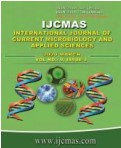


 National Academy of Agricultural Sciences (NAAS)
National Academy of Agricultural Sciences (NAAS)

|
PRINT ISSN : 2319-7692
Online ISSN : 2319-7706 Issues : 12 per year Publisher : Excellent Publishers Email : editorijcmas@gmail.com / submit@ijcmas.com Editor-in-chief: Dr.M.Prakash Index Copernicus ICV 2018: 95.39 NAAS RATING 2020: 5.38 |
Colour patterns are the most distinct phenotypic traits in the majority of the living organism including fishes and considered as one of the main influencing factors in consumers’ buying decisions. Color traits are regulated by mainly four types of pigments stored in chromatophores. Melanin, is one of the most important pigment of cells, responsible for the coloration. Tyrosinase is a characteristics enzyme in melanin biosynthesis. Modulation of tyrosinase is of significance in the ornamental fish industry, food fishes as well as in humans. By modulating the tyrosinase activity, it is possible to alter the body pigmentation and will help to develop different colour varities of fish and also treatment of hyper pigmentation disorder. The green spotted puffer fish (Teratodon nigrovirdis), an ornamental fish and Atlantic salmon (Salmo salar), an important aquaculture species were selected because of their commercial importance. The present study was aimed to characterize the tyrosinase enzyme of green spotted puffer fish (Teratodon nigrovirdis) and Atlantic salmon (Salmo salar) and to identify the natural compounds as putative modulators of tyrosinase. 3D models of tyrosinase protein were predicted by performing a comparative homology modeling program with the help of Chimera 1.1.3, Modeller and Swiss-model, and predicted structure was validated by the energy minimization method using SAVES Server including Procheck, Verify 3D and Errat tools. The physicochemical properties revealed that the fish tyrosinase protein is hydrophobic in nature, acidic, having a high extinction coefficient, unstable, thermolabile for a range of temperatures. The functional properties identified that T.nigrovirdis and S. salar tyrosinase protein sequence had transmembrane-segment and random coils dominated the secondary structure followed by an alpha helix, extended strands and beta turns. The results obtained from the Saves server showed that the models predicted by Swiss-model were more reliable compared to models developed by other tools. A structure-based virtual screening method helped to identify tyrosinase modulators. Three compounds out of 13000 from the ZINC database were identified as putative modulators of fish tyrosinase having binding energy -8.7 Kcal/mol to -8.2 Kcal/mol. Among which, 3-Methyl-2-phenylquinoline-4-carboxylic acid, 2-(4-chlorobenzyl)-5-(3-nitrophenyl)-2H-1,2,3,4-tetraazole and Kaempferol were considered as potential putative modulators as they had low binding energy and had acceptable properties for standardized drugs. Further, these compounds can be tested in-vivo for their efficacy and usefulness in altering the color pattern of the fishes.
 |
 |
 |
 |
 |